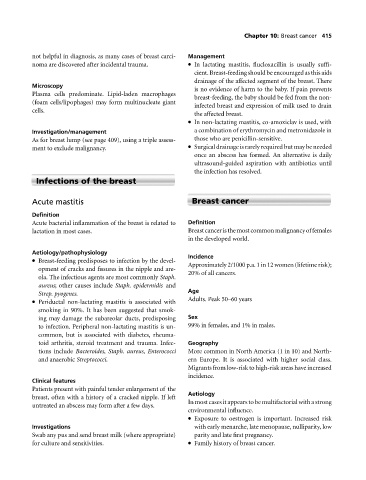Page 419 - Medicine and Surgery
P. 419
P1: KTX
BLUK007-10 BLUK007-Kendall May 12, 2005 20:3 Char Count= 0
Chapter 10: Breast cancer 415
not helpful in diagnosis, as many cases of breast carci- Management
noma are discovered after incidental trauma. In lactating mastitis, flucloxacillin is usually suffi-
cient. Breast-feeding should be encouraged as this aids
drainage of the affected segment of the breast. There
Microscopy
is no evidence of harm to the baby. If pain prevents
Plasma cells predominate. Lipid-laden macrophages
breast-feeding, the baby should be fed from the non-
(foam cells/lipophages) may form multinucleate giant
infected breast and expression of milk used to drain
cells.
the affected breast.
In non-lactating mastitis, co-amoxiclav is used, with
Investigation/management acombination of erythromycin and metronidazole in
As for breast lump (see page 409), using a triple assess- those who are penicillin-sensitive.
ment to exclude malignancy. Surgical drainage is rarely required but may be needed
once an abscess has formed. An alternative is daily
ultrasound-guided aspiration with antibiotics until
the infection has resolved.
Infections of the breast
Acute mastitis Breast cancer
Definition
Acute bacterial inflammation of the breast is related to Definition
lactation in most cases. Breastcanceristhemostcommonmalignancyoffemales
in the developed world.
Aetiology/pathophysiology
Incidence
Breast-feeding predisposes to infection by the devel-
Approximately 2/1000 p.a. 1 in 12 women (lifetime risk);
opment of cracks and fissures in the nipple and are-
20% of all cancers.
ola. The infectious agents are most commonly Staph.
aureus; other causes include Staph. epidermidis and
Age
Strep. pyogenes.
Adults. Peak 50–60 years
Periductal non-lactating mastitis is associated with
smoking in 90%. It has been suggested that smok-
ing may damage the subareolar ducts, predisposing Sex
to infection. Peripheral non-lactating mastitis is un- 99% in females, and 1% in males.
common, but is associated with diabetes, rheuma-
toid arthritis, steroid treatment and trauma. Infec- Geography
tions include Bacteroides, Staph. aureus, Enterococci More common in North America (1 in 10) and North-
and anaerobic Streptococci. ern Europe. It is associated with higher social class.
Migrants from low-risk to high-risk areas have increased
incidence.
Clinical features
Patients present with painful tender enlargement of the
Aetiology
breast, often with a history of a cracked nipple. If left
In most cases it appears to be multifactorial with a strong
untreated an abscess may form after a few days.
environmental influence.
Exposure to oestrogen is important. Increased risk
Investigations with early menarche, late menopause, nulliparity, low
Swab any pus and send breast milk (where appropriate) parity and late first pregnancy.
for culture and sensitivities. Family history of breast cancer.

